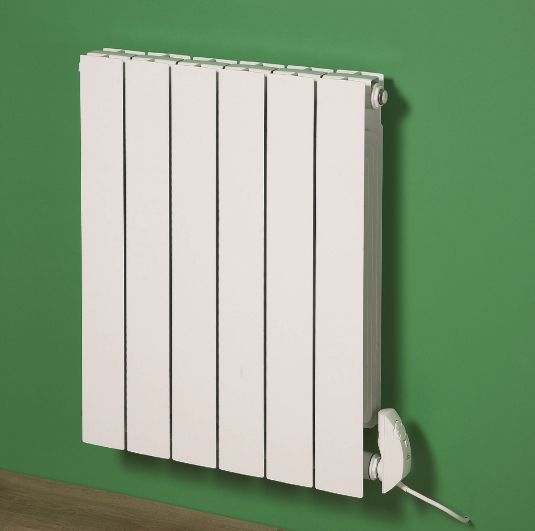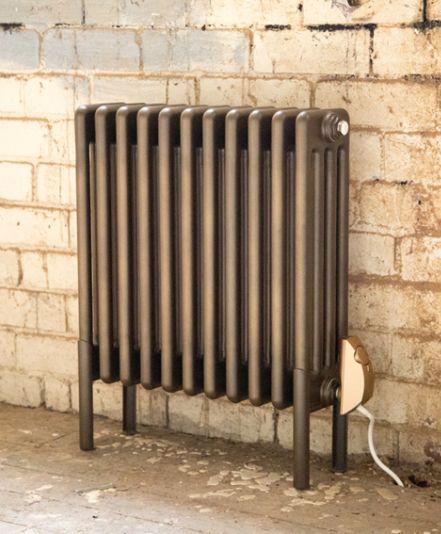Heating a Garden Building, Summerhouse or Posh Shed
- By Helena Gerwitz
- •
- 12 Jan, 2016
- •
In order for any garden building to be comfortable and useable, all year round, it will need to be heated. So what factors should you consider when choosing heating for a garden building? So what are the different heating options available for garden buildings? Copyright Feature Radiators.

The garden building business is blooming booming!
Thanks to technological advances aiding mobile communications and the ever-increasing costs of commuting, many of us are opting to work from home. A self-contained office in the garden provides the perfect environment to do just that.
The downturn in the economy has also played its part in the garden building boom. Financial uncertainty has resulted in a reluctance to move house, with homeowners choosing to stay put and improve and/or extend properties. In some cases this has led to the introduction of a garden building, whether used as a garden room, summerhouse or kids' den.
To get the maximum use from a garden building, heating (along with light and power) is a must. If the building isn't warm and cosy, then it won't be used, particularly in the colder winter months. This article looks at factors to consider when it comes to heating your garden building.
Insulation is key
Is there adequate insulation? Some, but not all purpose-built garden rooms, are adequately insulated. If you have converted a shed or outbuilding, or opted for a lower cost garden building, then you will probably need to add insulation. Without this, the cost of heating could be prohibitively expensive.
Add Heating
In order for any garden building to be comfortable and useable (for more than just storage), all year round, it will need to be heated.
So what factors should you consider when choosing heating for a garden building?
- Heat output - when choosing any form of heating it is critical that the option you select has the capacity to adequately heat the space. If in doubt, oversize the heater, as you can always turn it down.
- Thermostatic control - choosing a heating option with a thermostat will ensure that your garden building is heated optimally at a constant and comfortable temperature. Thermostatic controls provide efficient and cost- effective use of power; for instance, they can turn off a heater when the room has reached its optimum temperature; perfect on a sunny day for taking advantage of any "free heat" from the sun. By maintaining the temperature above a certain minimum level, you protect the contents of the building, including computers and soft furnishings, from cold or damp related damage.
- Timer - by opting for a product with a timer, you can ensure that the heating is on when it needs to be. A timer allows you to set the heating to come on just before you start your day, ensuring a toasty office in time for when you arrive.
- Space - by their very nature, many outbuildings are small in size. Therefore space is often a critical factor in choosing your heating option. These days, radiators are available in unusually narrow or low sizes, so there is likely to be something to accommodate even the most awkward of wall spaces. There are also floor-standing heaters, which are portable and take up no wall space.
- Budget - it may seem obvious, but costs vary immensely on heating options for garden buildings. For instance, the price of an electric heater can range from £20 for a basic fan heater to £2000 for the ultimate designer model. Take account of installation costs as well, for example if you opt for electric underfloor heating, bear in mind that installation costs may be considerable, especially if the floor needs to be taken up to allow the electric foil mat to be fitted underneath.
- Aesthetics - Whether your new space is for living or working, as well as wanting a comfortable and functional environment, you may also want to add style with an attractive looking heater; the many designs now available mean you can choose minimalism to aid focus, bright colours for inspiration or soft curves to give a relaxed feel.
So what are the different heating options available for garden buildings?
Water and oil filled electric radiators
The water inside a water-filled electric radiator is heated by an electric element and is used as a heat reservoir. Oil-filled electric radiators are heated electrically; the oil is not burnt but again is used as a heat reservoir. Both types of electric radiators work on the same principle and have similar running costs.
Pros
- Wall mounted and floor standing models available;
- Many floor mounted versions can be plugged into a socket, so there are no installation costs and the radiators are often portable;
- Wide range of contemporary and traditional styles available. From minimalist sleek designs like the Electric Thermalist (which is made of lightweight aluminium), to classic column style cast iron radiators like the Electric Etonian;
- Many are available with timers and thermostats; and
- Some styles heat up quickly (particularly those made of lightweight aluminium); others cool down slowly (such as those made of cast iron).
Cons
- The wall-mounted versions don't sit as close to the wall as some of the electric radiant panel radiators currently on the market.
Electric radiant panel radiators
Electric panel radiators radiate heat (rather than convecting it) and don't contain any liquid. These radiators have become extremely popular in recent times, due to their efficient, environmental and practical qualities. One of the best electric panel radiators around is the iRad, which is beautifully designed, slim, flat and sits close to the wall.
Pros
- Lightweight;
- Sits close to the wall;
- Many sizes, finishes and colours available;
- Heats up quickly;
- Radiates warmth without "blowing";
- Warms both objects and the surrounding air;
- Available with thermostats and timers; and
- Precise, focused, highly efficient heating.
Cons
- Almost always wall-mounted, so there will need to be at least some wall space available.
Wood burners
A wood-burning stove burns wood fuel and wood-derived biomass fuel whilst creating heat.
Pros
- Lovely cosy feel with attractive real fire flame;
- Carbon neutral, if fuel comes from sustainable sources;
- Warms both objects and the surrounding air; and
- Relatively low running costs.
Cons
- Safety concerns related to naked flames;
- Lack of controllability, which can lead to high temperatures;
- Sourcing and moving around fuel can be difficult and messy;
- Demands time and effort on a daily basis to keep it running;
- Ash created needs to be cleaned up;
- Requires reasonable amount of space, taking up both wall and floor space; and
- Significant installation costs.
Fan heaters
A fan heater works by passing air over a heating element, this heats up the air, which then leaves the heater, warming up the surrounding room.
Pros
- Heats up a room quickly;
- Warms both objects and the surrounding air;
- Relatively small so doesn't take up much floor space; and
- No installation costs.
Cons
- As soon as its switched off, the room will cool down quickly;
- Fan creates noise;
- Often unattractive;
- Uses a lot of energy resulting in high running costs; and
- Heat is blown out rather than convected or radiated, which can create a stuffy and snoozy environment.
Infrared heating panels
Infrared heating panels are a relatively new idea in the UK but have been widely available in Europe for more than ten years. Infrared heaters heat through the use of infrared waves.
Pros
- Focused heating, infrared waves only heat what they hit;
- Provide heat rapidly;
- Reasonably efficient to run;
- Can be fitted onto the ceiling to keep them out of the way; and
- Thermostats and timers available.
Cons
- Only heat the objects that the infrared waves hit. If you sit facing an infrared heater, then the back of your body and head and any part below the heater will remain cold;
- The surrounding air is not heated at all; and
- Potential fire hazard - As this heating is focused and direct, there may be a risk of fire if the heater is placed too close to an object. For example, if an infrared heater fell onto a wood floor.
Electric underfloor heating
Electric underfloor heating consists of a foil heat mat containing heating wires, which warm the floor surface which in turn heats the air above it. The foil mat must be laid under the laminate or wooden flooring intended for the garden building.
Pros
- No wall space required;
- Nice feeling under foot;
- When working to an optimum, whole room is evenly heated with an ambient background temperature;
- Many are available with thermostats and timers; and
- Relatively low running costs.
Cons
- May not have sufficient capacity to provide adequate heat for building - depending on level of insulation, ceiling height, and amount of glass;
- Relatively high installation costs;
- Insulated floor required;
- Must be installed under the floor, so may not be a desirable option where the flooring is already down;
- Slow to respond, can take up to 3 hours to get up to temperature, so forward planning needed and can take a long time to cool down;
- Limits choice of floor-coverings; and
- If it fails, the cost and inconvenience of repair will be significant, as flooring may need to be removed or replaced.
Portable gas heaters
Historically, a popular option for heating rooms or outbuildings particularly where there was no power source. Power is provided to these heaters via gas bottles that sit at the bottom of the heater.
Pros
- High heat output;
- Self contained heaters, requiring no external power source;
- No installation charges; and
- Portable.
Cons
- Safety - you must not place items on top or directly in front of gas heaters. This may be a challenge if you are working in a small space;
- Unpleasant gas odour;
- Adequate ventilation is vital to prevent a build up of dangerous fumes;
- Risk of carbon monoxide leak; and
- Large bulky items taking up valuable space, both when in use and in storage.
Conclusion
Whatever type of garden room heating you choose, you must ensure that it has the capacity to heat the relevant space. It is important to maximize the power used to efficiently provide heat whilst minimizing energy wastage through the use of good insulation, timers and thermostats.
Bear in mind that these days having a comfortable warm outbuilding doesn't mean you need to compromise on style with ugly, bulky and/or ineffective heating options. There is now a wide range of stylish, safe yet efficient electric heating solutions available.
For more information on finding the most suitable heating product for your garden building, speak to a radiator or heating expert.
Copyright Feature Radiators.
Credit: Feature Radiators
Electric Radiators UK now offer iRads, electric heating that doesn't cost the earth. Good looking, efficient electric radiant panel radiators for use alone or together for a complete central heating system, with innovative wireless control. With no boiler and no pipes, installation and maintenance costs are slashed, and with highly targeted, controllable heat, when and where you want it, energy is used intelligently and efficiently. The smart money is on iRads.
For more information, call our team on 01274 567789.
Credit: Feature Radiators
Electric radiators are an increasingly popular option and Electric Radiators UK offers a wide range of electric heater styles including a number of column, cast iron and traditional style radiators. We can offer such a large range as we can supply central heating radiators with a DIY electric element kit to convert some of them into electric models.
This video shows you how to convert a central heating radiator into an electric version with the installation of an electric element.
All our electric radiators can be controlled via PC, tablet or smartphone using our smart app technologyand/or linked to form a centrally controlled electric heating system. Call our expert team on 01274 567789 for more information.
Electric radiators and electric heating systems is becoming more common in homes in the UK. So here our expert, Jason, provides a beginners guide to electric radiators, how to judge the efficiency and what choice in electric radiators are now available.
Electric Radiators UK offers a huge range of models, sizes and finishes of electric radiators including traditional and contemporary radiators. We also offer a range of different levels of controls for electric radiators including smart controls to enable radiators to be controlled via PC, tablet or smartphone.
For expert advice on electric radiators, please call our team on 01274 567789 or visit http://www.electric-radiators.uk


